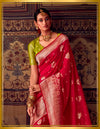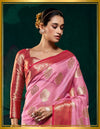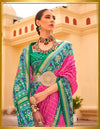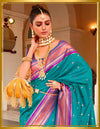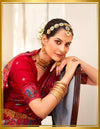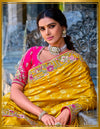23 Kanjivaram Saree Motifs | Traditional Motifs of Saree in India
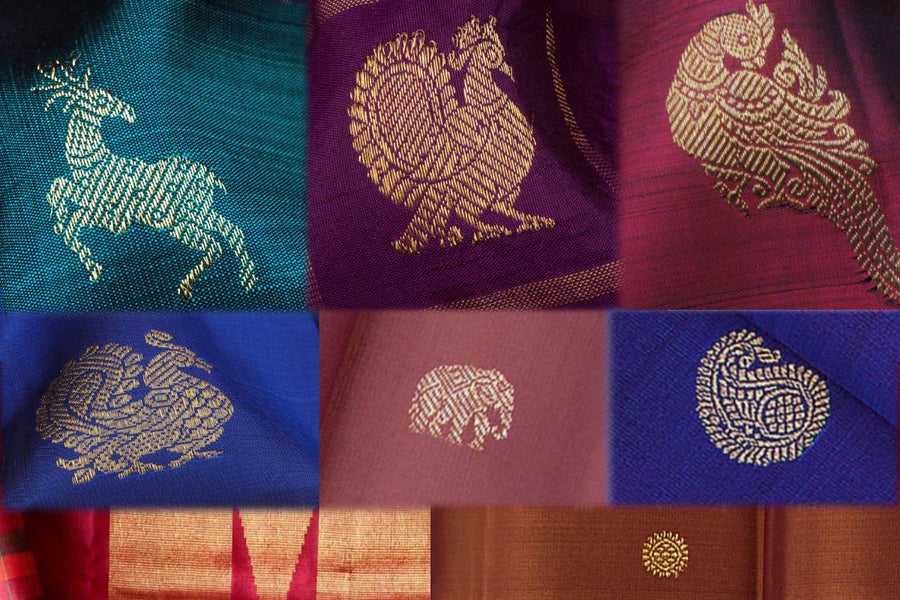
Motifs in a Kanjivaram saree represent centuries of Indian tradition, spirituality, and art of skilled weavers who take inspiration from local temple architecture, flowers, animals, birds, and ancient Hindu mythology.
You will notice small and repetitive designs accentuating the borders and pallu, while single floating motifs, or buttas, appear on the saree body. From the revered lotus (kamalam) to the stylized mango (maanga), and from creeper designs (kodi visiri) to sacred symbols like Rudraksha beads, each motif tells a tale.
Motifs of Kanjivaram Sarees With Pictures
1. Kamalam Motif (Lotus)

The lotus, or “pundarika,” is considered very divine in India and symbolises purity and prosperity. Lotus is associated with goddesses like Lakshmi Devi, Saraswati Devi, and Brahma Deva. The flower’s ability to bloom in muddy waters is what makes it a metaphor for spiritual growth amidst challenges. In Kanjivaram silk sarees, the lotus motif is stylized into a graceful eight-petal design called kamalam. Unlike the lotus patterns in Varanasi brocades, the Kanchipuram version is minimalist but expressive which showcases the creative flair of the weaver.
2. Kili Motif (Parrot)

The parrot, or Kili, holds a special place in South Indian culture as a representation of truth and spiritual teachings. Sage Suka and Sage Arunagirinathar are said to have taken the form of parrots to compose revered texts. Parrots are often associated with goddesses like Meenakshi and Andal and with the God of Love, Kamadeva. This motif is a popular choice for bridal silk sarees across India, including Kanjivaram, Paithani, and Patola sarees. The vibrant green of the parrot, known as kilipacchai, is a favourite shade in Kanjivaram designs.
3. Mayil Motif (Peacock)

The peacock, or Mayil, symbolises majesty and divinity. The Tamil word thogai, meaning peacock, influenced the Hebrew word thukkiyam, mentioned in the Old Testament. Peacocks are linked to Lord Murugan, whose vahana (vehicle) is a peacock. The 12th-century text Yaperungala Vriti describes Kanchipuram as a peacock, with Athiyur (Varadharajaswamy temple) as its head and Shaiva Kanchi temple as its body. These connections inspired the mayil chakaram motif, a staple in Kanjivaram sarees.
4. Godhumai Motif (Wheat)

Wheat, or “godhumai” in Tamil, symbolizes fertility and abundance. Even though South India is known for its rice cultivation, wheat also has important cultural value and is a staple in many regional dishes. The godhumai motif represents wheat kernels in a geometric pattern and is found on saree borders or pallus. Woven in zari or silk threads, these shimmering wheat motifs honour the region’s agricultural richness.
5. Vazhaipoo Motif (Banana Blossom)

The Banana is an integral part of South Indian culture. Banana (Arati) fruit, stem, and flowers play key roles in Hindu Festivals, Weddings and Cuisine. The vazhaipoo, or banana blossom, is transformed into horizontal stripes or alternating patterns in Kanjivaram sarees, known as “aathi vazhai” in Tamil. Often highlighted with fine zari, the Vazhaipoo motifs add bold yet harmonious geometry to the saree, celebrating the importance of the Plant.
6. Annam Motif (Hamsam) – The Swan

The swan which is known for its beauty is a significant motif in Kanjivaram sarees and the Hamsam inspiration is drawn from the beautiful carvings of Kanchipuram temples. Also Known as Annapakshi, the Swan motif has historical roots in Gandharan and Kushan sculptures and was later incorporated into temple art and Hindu iconography. In ancient literature, the swan is referred to as Chakravaha which symbolises fidelity. Kalidasa’s epic Kumarasambhava mentions a saree called Hamsa Dukula, adorned with swan motifs, as part of the heroine’s bridal attire.
7. Kodi Visiri Motif (Creeper)

Creepers are called “kodi visiri” in Tamil and are inspired by floral designs that are found on Hindu Temple Pillars and Gopuram. The Creeper motifs feature tendrils winding gracefully around flowers and leaves and symbolize growth and continuity. In Kanjivaram sarees, kodi visiri patterns decorate the borders and pallu, adding a flowing, dynamic quality to the saree’s design.
8. Malli Moggu Motif (Jasmine Bud)

Jasmine, or “malligai,” is an essential part of Tamil Nadu’s cultural fabric. Jasmine flowers are extensively offered to Deity in Temples, used in wedding garlands, and decorations and adorn bridal hair. The malli moggu motif captures the soothing beauty of jasmine buds and appears as small buttas scattered across the saree. Known as “raindrops,” the Malli Moggu motifs bring a sense of charm to the fabric.
9. Kasa Kasa Kattam Motif (Poppy Seed Checks)

The tiny white poppy seeds, or “kasa kasa” in Tamil, inspire this checkered design. Poppy seeds are known for their culinary and therapeutic uses, and their appearance is mirrored in the checks woven into Kanjivaram sarees. These kasa kasa kattam patterns which are enhanced with zari, become visible in their full glory only when the saree is draped.
10. Panai Maram Motif (Palmyra Tree)

The palmyra tree, or “panai maram,” is native to Tamil Nadu and serves as a muse for Kanjivaram motifs. The leaves of the Palmyra tree are used to craft baskets and fans which is the inspiration for the “paai madi” weave. This basket-like criss-cross pattern is derived from Chettinad crafts and forms the ground fabric and pallu of many sarees. The Panai Maram pattern honours the artisanal heritage of Tamil Nadu.
11. Puliyam Kottai Kattam Motif (Tamarind Seed Checks)

Tamarind seeds, or “puliyam kottai,” are used in traditional games like pallankuzhi and are an important ingredient in dishes like vatha kuzhambu and sambar. The unique shape of tamarind seeds inspires these checkered motifs which are woven across the saree body in vibrant colour combinations.
12. Rudraksham Motif (Rudraksha Beads)

According to ancient Hindu mythology Skanda Purana, the rudraksha beads are originated from the tears of Lord Shiva. These Rudraksha beads are believed to ward off the evil eye and misfortune. The Rudraksha motifs look striking when woven into kanchi silk saree borders or as larger buttas on the body. By blending mythology with art, the rudraksha motif adds a sense of spirituality and auspiciousness to the saree.
13. Manga Motif (Mango)

The mango motif, or “maanga,” holds a unique place in Indian textiles. The Sthala Vruksham is the mango tree of the Ekambareswarar temple in Kanchipuram which is said to have four branches yielding different types of mangoes. The Manga motif is not only spiritually significant but also versatile in its artistic execution. In Kanjivaram sarees, the Manga motif appears on borders, the mundhanai, and as small buttas. Known globally as paisley, the mango motif represents abundance, wealth, and innovation, blending South Indian and Persian influences seamlessly.
14. Maan Motif (Deer)

The deer, or Maan, symbolizes innocence and gentleness. The golden deer from the Ramayana serves as inspiration for this motif, which is rare in Kanjivaram sarees but breathtaking when featured. The deer also appears in the iconography of Lord Shiva and is the vehicle of Vayu, the god of wind.
15. Thuthiripoo Motif (Indian Mallow)

The Indian mallow, or “thuthiripoo,” is inspired by garlands of flowers like arumbu, lavangapoo, and sampangi. The Thuthiripo motif resembles scattered flowers and enhances the border compositions of the kanjivaram saree. The Thuthiripoo Motif brings to life the joy of celebrations and transforms the Kanchipuram saree into a poetic expression of beauty.
16. Thazhampoo Reku Motif (Kewra Flower)

This temple motif, inspired by the gopurams of South Indian temples, is central to Kanjivaram sarees. The “reku” design mimics temple gateways, representing divinity. The thazhampoo, or kewra flower, adds a feminine touch, representing purity. These motifs, whether in large triangles or smaller “pillayar moggu” patterns, infuse the saree with spiritual vibrancy.
17. Iruthalaipakshi Motif (Two-Headed Eagle)

The two-headed eagle, or Iruthalaipakshi, is a powerful symbol of victory. Known as Ganda-bherunda in the history of the Mysore Kingdom, it was an insignia of the Wodeyars and later appeared in Vijayanagara coins. This Iruthalaipakshi emblem is usually woven into Kanjivaram sarees with gold zari or vibrant silk zari threads which decorate the pallu and body, adding an aura of regal splendour.
18. Simham Motif (Lion)

The lion, featured prominently in the Vaikunta Perumal temple’s outer praharam and Pallava-era monuments, symbolizes the power and tejas (brilliance) of Goddess Durga. This royal animal also appears in the mystical Yazhi, a composite mythical beast. In Kanjivaram sarees, lions are woven as linear motifs along borders and pallus, reflecting strength.
19. Yaali Motif – The Mythical Guardian

The Yaali, a composite creature combining traits of a lion, elephant, and horse, is a protective motif in Tamil temple architecture. Found in gopurams and corridors, yaali varisai (rows of yaalis) are crafted to guard temples. In Kanjivaram sarees, variations such as simha yaali (lion yaali), yanai yaali (elephant yaali), and hamsa yaali (swan yaali) adorn the borders and pallus, symbolizing unmatched strength.
20. Meen Motif (Fish)

The fish, or Meen, is a potent fertility symbol with origins in the Indus Valley Civilization, where it appeared on pottery and seals. Adopted as the emblem of the Pandya dynasty, the Meen motif is commonly woven along saree borders, known as meenpettu, and is also prominent in Orissa and West Bengal textiles. It carries Vaishnavite associations, making it significant in Indian culture.
21. Yanai Motif (Elephant)

The elephant, or Yanai, is an auspicious symbol of Strength and wisdom. In south Indian temples, you can find rows of elephants that appear to support structures that represent their protective and powerful nature. Commonly seen in Kanjeevaram sarees, marching elephants on the borders and pallus add grandness and cultural richness.
22. Kuthirai Motif (Horse)

Horses galloping along the borders and pallus of Kanjivaram sarees depict energy. Inspired by temple sculptures and rural art, such as the terracotta mannkuthirai of Ayyanar, the Horse motif also reflects the festivities of Tamil Nadu, where horses are associated with divine processions. The Vana Singaram hunting scenes in South Indian brocades also feature this majestic animal.
23. Kuyilkann and Mayilkann (Cuckoo and Peacock’s Eye)

These intricate diamond mesh designs, inspired by the eyes of the kuyil (cuckoo) and mayil (peacock), adorn the borders of Kanjivaram sarees and also men’s veshtis. The mayilkann veshti, with its striking Ganga Jamuna borders in red and green, is traditionally worn by bridegrooms. The mayilkann design is slightly larger and heavier, while the kuyilkann has a delicate dot at its centre, making both patterns timeless favourites in Kanjivaram textiles.
These motifs are more than designs; they are stories woven into silk, celebrating the skill and creativity of Tamil Nadu’s artisans. Whether it is the sacred rudraksha or the majestic mango, each silk saree carries a legacy of tradition.
 New Arrivals
New Arrivals
 Saree Weaves
Saree Weaves
 Banarasi Sarees
Banarasi Sarees
 Kanjivaram Sarees
Kanjivaram Sarees
 Paithani Sarees
Paithani Sarees
 Patola Sarees
Patola Sarees
 Organza Sarees
Organza Sarees
 Chikankari Sarees
Chikankari Sarees
 Kashmiri Jamawar Sarees
Kashmiri Jamawar Sarees
 Dola Silk Sarees
Dola Silk Sarees
 Dharmavaram Silk Sarees
Dharmavaram Silk Sarees
 Saree Fabric
Saree Fabric
 Silk Sarees
Silk Sarees
 Soft Silk Sarees
Soft Silk Sarees
 Linen Sarees
Linen Sarees
 Satin Sarees
Satin Sarees
 Digital Printed Sarees
Digital Printed Sarees
 Tissue Silk Sarees
Tissue Silk Sarees
 Occasion
Occasion
 Festive Wear Sarees
Festive Wear Sarees
 Office Wear Sarees
Office Wear Sarees
 Party Wear Sarees
Party Wear Sarees
 Luxe Collection
Luxe Collection
 Wedding Collection
Wedding Collection
 Engagement Sarees
Engagement Sarees
 Haldi Sarees
Haldi Sarees
 Sangeet Sarees
Sangeet Sarees
 Wedding Banarasi Sarees
Wedding Banarasi Sarees
 Wedding Kanjivaram Sarees
Wedding Kanjivaram Sarees
 Wedding Organza Sarees
Wedding Organza Sarees
 Wedding Patola Sarees
Wedding Patola Sarees
 Sarees By Color
Sarees By Color
 Price Range
Price Range
 Designer Silk Sarees
Designer Silk Sarees
 Track Your Order
Track Your Order
